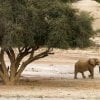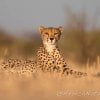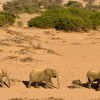The story of a dead wildebeest
I never imagined that observing animals in the wild would lead me to an understanding of death as a natural event, integral to life. The death of one wildebeest might not change the rhythm of life upon the savannah, but it is highly important for the continuation of the lives of other animals.
… Namibia’s Etosha National Park … there was a pink hue in the sky above… Everybody was waiting for the rains, which were late arriving…
7.15 a.m. … noticed in the distance a black heap with five black-backed jackals (Canis mesomelas)… The black heap was a recently-dead wildebeest (Connochaetes taurinus). It had presumably died of natural causes, as it showed no signs of wounds…
The jackals looked as if they couldn’t believe their luck at having found such abundance, and they were running around in a frenzy…there were only five jackals, they began to compete… There was more than enough meat to satisfy them all, but they fought over it nonetheless…the pack hierarchy was clearly too strong.
…They ran around wildly, growling and yelping and biting. This soon caught the attention of other jackals in the area, and it wasn’t long before their number had grown and the competition became ever fiercer. The supremacy of certain jackals over others was quite apparent, the weaker ones being driven away the moment they got near.
… Such a hard life!
9.45 a.m. By now the sun was beating hard…Even the jackals had to take turns… to rest for a moment under the shadow of a thorntree. The temperature was still rising, and we had been shut in the car for over three hours without air conditioning or the chance of getting out (which is not allowed inside the park). We needed a break and a cold drink.
10.30 a.m. When we got back, we were surprised at how the scene had changed. The jackals now had new competition and had to work with more aggressive determination to defend their pickings. The new arrivals weren’t to be put off easily and had their advantage in numbers: they were vultures (Gyps africanus and Torgos tracheliotus) and several marabou storks (Leptoptilos crumeniferus).
What a scene! And those poor jackals thought they had the wildebeest all to themselves.
2.30 p.m. More than half the carcass had been devoured, with the ribs in plain view. For our part, we were exhausted… and go back to the camp in search of some shade – not only for ourselves, but for the cameras, which were overheating.
6.30 p.m. By the time we got back, the vultures had all gone, and there were just two jackals left. These had been joined by three large hyenas (Crocuta crocuta) that, very excited about their discovery, started to bicker among themselves over the little meat that was left…
The hyenas carried on fighting, dragging the skeleton around and disappearing into clouds of dust. The day was drawing to a close and the sun was beginning to set… The shadows lengthened as the last rays of sunlight picked out thousands of scattered feathers that the vultures had left behind.
We had witnessed the struggle for food, and the dominance hierarchy. We had watched the interaction of different species and seen the importance of the scavengers of the savannah… The death of the wildebeest had meant survival for others, playing its part in the circle of life.



